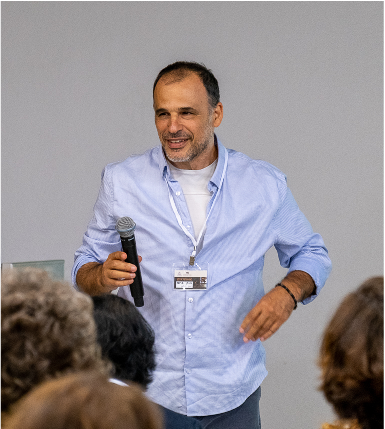Smovey Hoops
Hello friends,
My blog #7. I want to share with you the progress of our research in understanding the molecular basis of the disease and also the solution I chose to deal with further worsening of my disease.
I will start with the solution I chose to deal with my illness. In the last months I have more stiffness and more difficulty walking normally. I met with my amazing neurologist, Dr. Nirit Lev, and after a careful examination she told me that there was no worsening in my indices, but because of my feeling, she recommended that I start taking Cinnament, one of the derivatives of dopamine.
It was hard for me to hear her distinction but I felt she was right. It scares me to start taking dopamine, but if it will improve my quality of life, then it's probably worth it. But even so the doubt still nested in me. Is there an "escape route"? In the last months I was under high pressure at work and this may have had an effect on the aggravation. So maybe I'll wait a little longer and see if there's an improvement. Am I kidding myself? So, I bought the medicine and put it in the drawer. Reconciliation (?) with the situation and perhaps an opening to another solution.
And then it arrived. One morning I opened the closet and the Smovey rings looked at me. If you are interested, go online and see what these hoops are. A patient from Austria developed them and I received them as a gift from a patient in the USA a year ago and they have been waiting for me ever since. In short, it is a hoop with a sleeve and inside it a piece of metal that slides from side to side while walking (each hand holds a hoop). The hoops give rhythm (like a metronome), some weight, and grip - together they help me improve coordination and the ability to return to a "normal" walk.
And another important point: I introduced the march with the hoops into my daily routine; Before and after the train - a total of 15 minutes a day. My moral from this experience: 1) don't rush to take medicine or increase doses, and try to look for alternatives where I allow the body to solve the aggravation by itself; 2) I need to find the movement/activity that suits me. My hoop is painted green and it feels like a toy/jewelry that I enjoy playing with. As well as basketball that I returned to play a few months ago - the ball is also a type of toy. I played five on five this week along an entire court and it was exhausting but very satisfying!
How is our science progressing? In recent months, we found that Alpha-Synuclein (AS), the protein that causes the disease, clings to the mitochondria - due to the mitochondria working harder than usual to cover up a breakdown in its activity (in the professional jargon, "disruption of coupling"). So, AS comes to the rescue? We think so by switching the energy generation from the damaged mitochondria to the "healthy" glycolysis. Basically, AS's function is probably to relieve the mitochondria and prevent further damage to the cellular and physical environment (for example mitochondria with a coupling violation produces heat instead of producing energy; like a damaged engine).
So how does the disease develop? AS makes his best efforts to replace the source of energy but he is also a "human being" and after years of hard work he also gets tired. In addition, it is known that during the development of the disease the mitochondrial cycle process (mitophagy) is also impaired and as a result there is an accumulation of damaged mitochondria that produce heat and free oxygen radicals, which lead to the development of inflammation. This new reality probably causes AS to create clusters, which are apparently inactive and very toxic to the cells of our bodies.
If the picture I drew is correct then what solutions do I have to offer? One of the proposals is the injection into the circulation of healthy mitochondria from an external source. Curious? Read my next blog that I will write soon.
Thanks for listening

Comments
Post a Comment